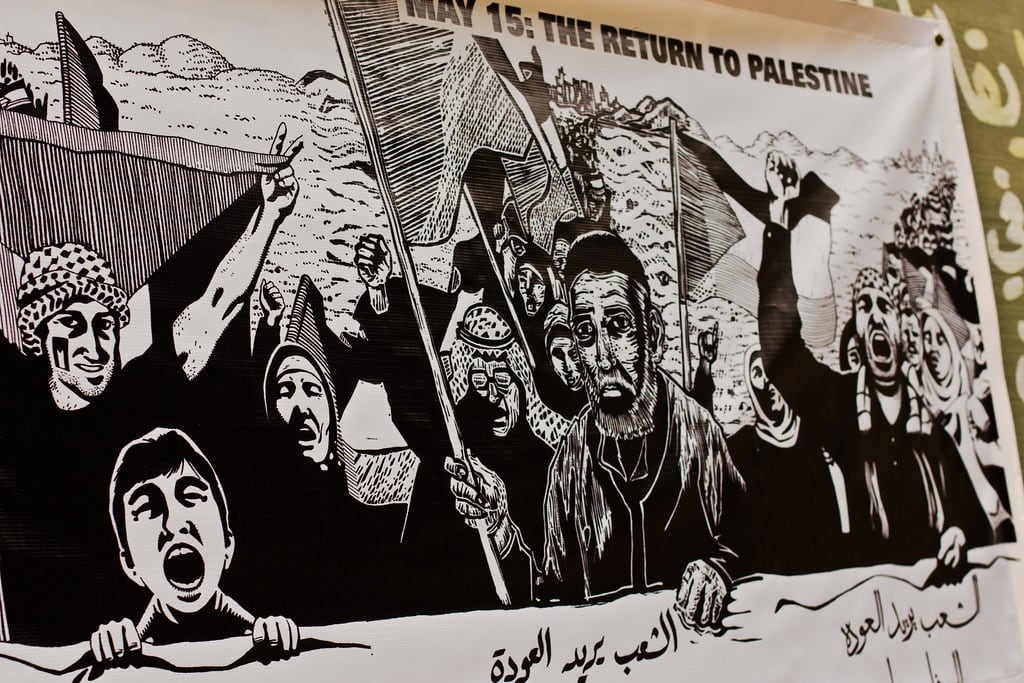
In November 2023, during the first phase of the genocide in Gaza, I published a text in Allegra Lab, asking how the word “ceasefire” could be such a politically sensitive demand that leaders and actors around the world – even the UN Security Council– needed to cover it behind the words “humanitarian pause.” It was as if a humanitarian pause would be less threatening than the kind of pause a ceasefire would imply. As an anthropologist studying humanitarianism in the Middle East, I argued that it was the most striking example of how humanitarian language is used to hide politics. If humanitarianism was ever a space for politics, as Ilana Feldman argues (2018), it was for mobilizing political agendas behind perceivably neutral and unthreatening words.
Fast forward to October 2025. While we have for the last two years witnessed a livestreamed genocide – with the systematic destruction of lives, schools, homes, and hospitals – Western leaders continue to deny what the ICC, the ICJ and UN human rights mechanisms established more than a year ago. Recently, however, something resembling a ceasefire has been implemented as part of President Trump’s so-called “peace plan.” It represents the first phase of an international attempt to engineer some sort of peace. Far from representing a “new beginning,” however, the plan is at best “a roadmap” to free the Israeli hostages and condition Palestinians’ present and future under new forms of Israeli and international domination (Tartir 2025). For reading the 20-point plan drafted by Trump, any mention of Israel’s war crimes, let alone its settler colonialism, occupation of Palestinian land, and apartheid system, is nowhere to be seen. Instead, Israel’s withdrawal from Gaza is conditioned by the disarmament of Hamas.
This denial of Israel as a perpetrator of war crimes is neither new nor surprising. On the contrary, it is arguably what has sustained its colonial project in Palestine, as well as what has enabled its genocidal war. Beyond maintaining the status quo of Israel’s occupation of Palestine, the case of Gaza demonstrates that such denial also has dangerous implications for humanitarianism.
There has, to say the least, been too much violence to keep track of over the last two years. Too many deaths. Too many empty talks about humanitarian solutions. Does anyone even remember the short-lived, temporary US aid pier in Gaza and all its controversies? While Israel was blocking all international aid from entering Gaza, the Biden administration – instead of putting pressure on Israel – built a 370-metre floating pier so that aid could enter via the sea. Criticized by aid groups as a “costly distraction” from the elephant in the room – Israel consciously withholding humanitarian assistance – the pier operated only for 25 days before it was dismantled as the weather made it impossible to function. Airdropped aid parcels are another example of how states sought to solve Israel’s aid blockade without addressing the root causes of the problem or putting any pressure on Israel. The result was parcels of food falling from the sky, sharing the same airspace as Israel’s bombs and paper leaflets ordering people to evacuate their homes.
These events reveal that there is evidently much more than subtle politics that can hide in the humanitarian space.
These events reveal that there is evidently much more than subtle politics that can hide in the humanitarian space. Beyond offering refuge for different actors to make political claims, it also provides a recipe for distraction. That is, ways for states to implement ‘humanitarian solutions’ while at the same time avoiding holding the perpetrator accountable. Consequently, the humanitarian space has, over the last two years, become a hideout for Israel’s genocidal strategies. What we have seen repeatedly since October 2023 is how this avoidance has enabled Israel to mobilize humanitarian politics for its own criminal endeavours. Is it too much to say that the humanitarian space in Gaza has become a killing machine in disguise? Or how should one otherwise conceptualize death traps wrapped in a language where the adjective “humanitarian” decorates nouns like “corridor,” “zone,” and “city”? Khan Younis was a so-called “humanitarian zone.” A place from which we witnessed refugee tents on fire and people being burned alive. A place that Israel bombed almost 100 times. The routes described as “humanitarian corridors” in Gaza were and are anything but safe. Instead, both civilians and aid workers have been deliberately killed while on the move. In July this year, the Israeli defence minister proposed to make a “humanitarian city” on the ruins of Rafah. What is a “humanitarian city” if not another word for refugee camp? Or, to use the words of the former Israeli PM, a concentration camp? According to UN experts, the use of the word “humanitarian” is “an insult to the humanitarian enterprise and standards” (United Nations 2025).
Israel has undeniably hijacked the humanitarian space. But this appropriation does not end at language, which brings me to one particular genocidal strategy mobilized by Israel: the US-backed Israeli NGO, Gaza Humanitarian Foundation (GHF). Created based on accusations – without evidence – that Hamas was stealing aid from the UN, in May 2025, GHF took over the aid distribution in Gaza previously performed by UN agencies. As a result, reaching aid distribution points and waiting for aid became a dangerous, even deadly, endeavour. A journalist in Gaza under the pseudonym Jannat Youssef described conditions under which receiving aid was a life-or-death battle. She wrote in Haaretz that aid centres “have become death arenas where hunger and bloodshed define survival.” Either people returned with some food to feed their family, or they did not return at all. She called it a real-life Squid Game. The only difference is that in Gaza, there was no prize – only more death and destruction.
Condemned by UN experts and International Human Rights organizations, both for undermining the established aid apparatus and violating humanitarian principles, the actions of GHF expose the structural limits of humanitarianism more than ever and put everything it stands for into question. Driven by a “politics of compassion” (Fassin 2012), humanitarianism has, throughout history, sought to safeguard a space where ethics can co-exist with violence and war. The understanding that such a space always deserves to be preserved, even in the most violent and unjust contexts, is what enables humanitarian actors to operate with the agreement of ruling state powers (Barnett 2011; Duffield and Donini 2014; Barnett 2001). Critical scholarship has revealed how preserving such a space unintentionally reinforces, rather than disrupts, various forms of state violence (Duffield 2007; Ramsay 2020; Pandolfi 2003). In the context of the Israeli occupation of Palestine, this is visible in the way aid is always negotiated through the administrative mechanisms of Israel’s colonial apparatus – making aid organizations complicit in maintaining the status quo (Billaud 2024).
What we have been witnessing in Gaza, however, is arguably something worse than a failure to initiate systematic change via the state system.
What we have been witnessing in Gaza, however, is arguably something worse than a failure to initiate systematic change via the state system. Rather, we see an occupation force consciously refusing the established humanitarian apparatus and shamelessly creating a pseudo-alternative to camouflage its own criminal actions. No need to negotiate, justify, or strike of compromise with anyone anymore. The result, as we see, is horrifying.
The real-life Squid Game in Gaza raises the question of how we are to approach the structural limits and dangers of the humanitarian space, taking into account that it can evidently be hijacked and used as camouflage by the killing party. What will the future of humanitarianism look like after Israel’s blatant hijacking of the humanitarian space to cover up its genocidal war on Gaza? Can something like “a humanitarian space” even be maintained in a context of apartheid and occupation?
Two years into this genocide, the same actors who in 2023 demanded a “humanitarian pause” instead of a ceasefire now celebrate the prospects of a distorted peace (Tartir, 2025) while ignoring questions of justice and accountability. Clearly, it is not only humanitarian language that gives way to political denial. In the same spirit, beyond diverting attention from Israel’s war crimes, the language of peace frames the situation in Gaza as if it were a matter of war – not settler colonialism, not apartheid, not occupation, and certainly not genocide. For this reason, Trump’speace plan will do nothing more than extend Israel’s immunity from accountability and deny Palestinians’ meaningful ownership of and participation in the path forward (Tartir, 2025). Under these circumstances, how can humanitarianism – and the space it seeks to preserve – possibly recover?
Bibliography
Barnett, Michael. 2001. “Humanitarianism with a Sovereign Face: UNHCR in the Global Undertow.” International Migration Review 35 (1): 244–77.
Barnett, Michael. 2011. Empire of Humanity: A History of Humanitarianism. Cornell University Press.
Billaud, Julie. 2024. “Prisoners of Humanitarianism: Complicity and Resistance in the Occupied Palestinian Territory.” Today’s Totalitarianism, November.
Duffield, Mark. 2007. “Development, Territories, and People: Consolidating the External Sovereign Frontier.” Alternatives 32 (2): 225–46.
Duffield, Mark, and Antonio Donini. 2014. Global Governance and the New Wars: The Merging of Development and Security. Bloomsbury Academic & Professional.
Fassin, Didier. 2012. Humanitarian Reason: A Moral History of the Present. University of California Press.
Feldman, Ilana. 2018. Life Lived in Relief: Humanitarian Predicaments and Palestinian Refugee Politics. University of California Press.
Pandolfi, Mariella. 2003. “Contract of Mutual (In)Difference: Governance and the Humanitarian Apparatus in Contemporary Albania and Kosovo.” Indiana Journal of Global Legal Studies 10 (1): 369–81.
Ramsay, Georgina. 2020. “Humanitarian Exploits: Ordinary Displacement and the Political Economy of the Global Refugee Regime.” Critique of Anthropology 40 (1): 3–27.
Tartir, Dr Alaa. 2025. “Recognizing Palestine, Unrecognizing Palestinians.” Arab Reform Initiative, September 24.
United Nations. 2025. “UN Experts Call for Immediate Dismantling of Gaza Humanitarian Foundation – Press Release.” Question of Palestine.
Abstract: This piece focuses on Israel’s mobilization of humanitarian language in its genocidal war against Palestinians. Western leaders’ continuous support to Israel’s war crimes has ultimately enabled Israel to hijack the humanitarian space. Such a hijack extends far beyond language: More than hiding its genocidal crimes behind the adjective “humanitarian,” the creation of the Gaza Humanitarian Foundation demonstrates its blatant violation of humanitarian principles. Attending to the horrifying results of this instrumentalization, I ask: Can something like a humanitarian space even be maintained in a context of apartheid and occupation?





